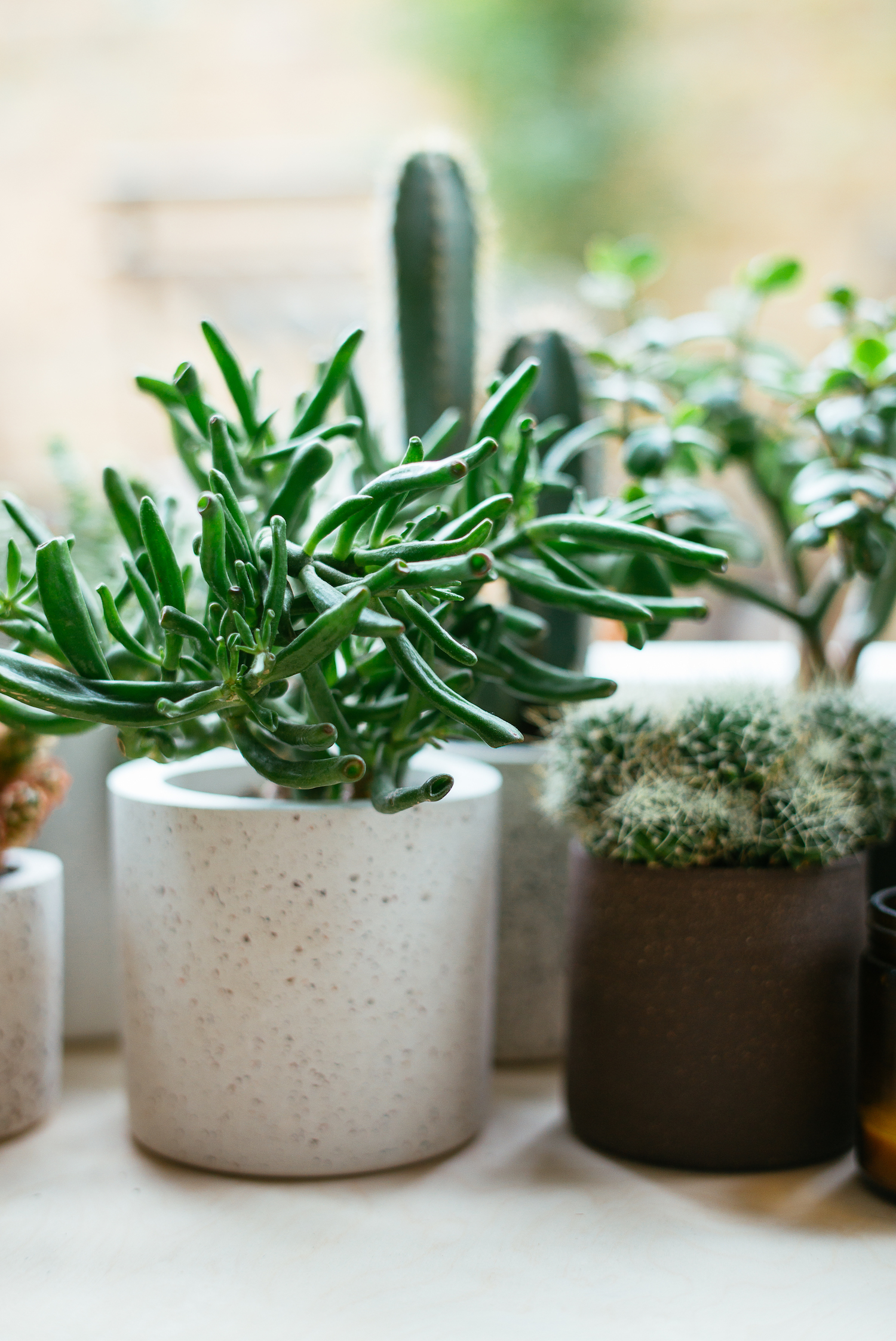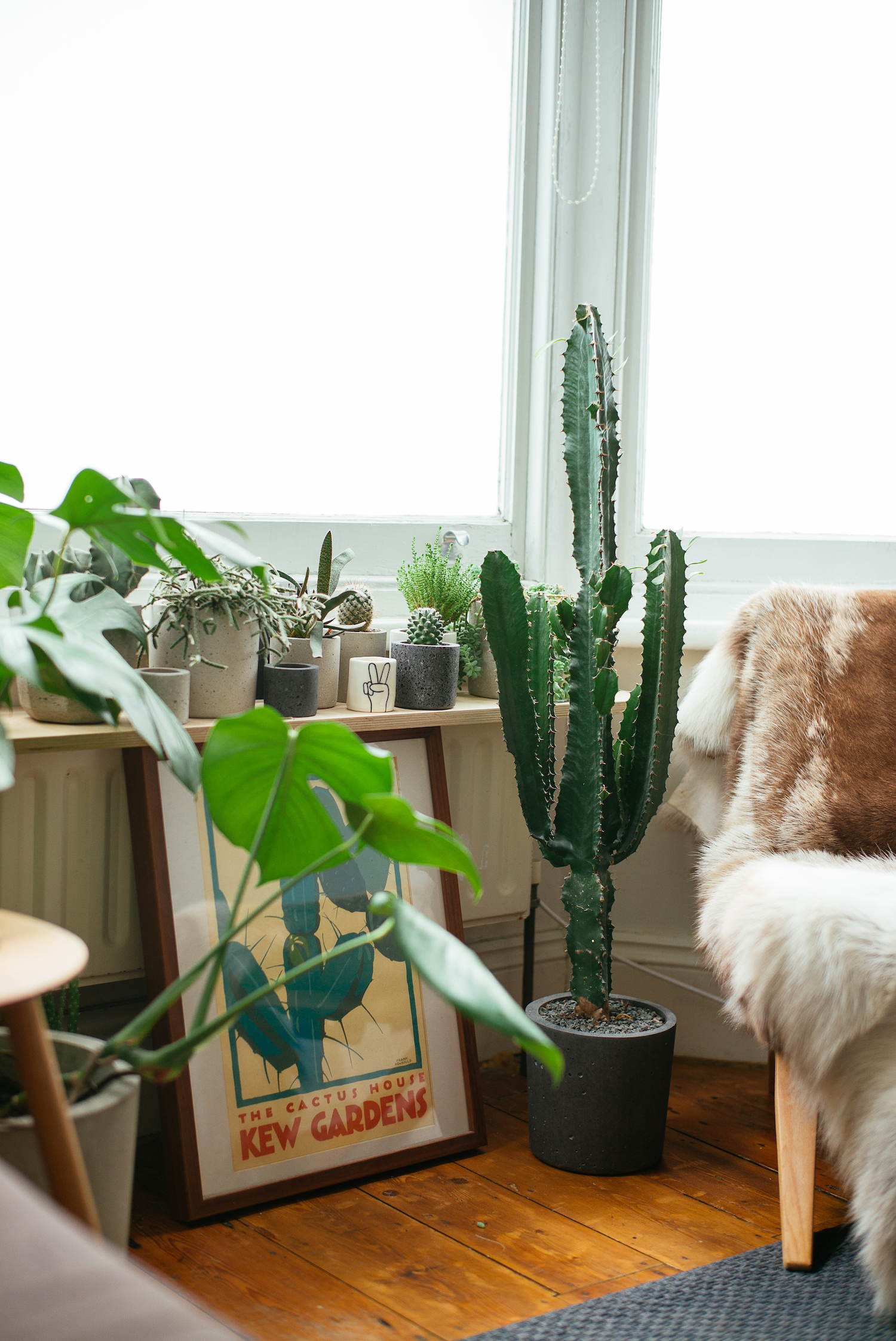Plants For City Living

Plants for City Living by Conpot
Rented accommodation leaves little opportunity for a personalised interior. Decoration needs to be nomadic, with each year’s rental review dictating whether you can afford to stay in your home. It’s hard to invest in anything permanent; we have a cactus that completely changed stature from the previous address to the current. Once short and stocky with dense growth, it suddenly changed in character upon moving to Peckham with skinny fingers stretching upwards from the bulky palm of a hand.
Our first house plant was a half price palm – sad looking, with a few stumps of severed fronds lost to neglect. The Radio 4 Gardeners’ Question Time panel always screams to 'keep walking' when you see these sad neglected plants at cut prices; they don’t need a saviour and will make perfectly good compost. But we persevered with ours and despite looking sad for a few seasons, the plant is now beginning to outgrow our small London flat, a triumph against adversity. We are anything but experts at looking after plants, but hopefully through our experience of successes (and failures), the following will help guide you to houseplant success.
Our flat is typical for South East London. Formerly a Victorian terraced house, now split into three flats, we occupy the ground floor, a narrow slither of a building one room wide with a small walled garden at the back. The road runs south to north, therefore our windows face east and west. The flat may as well be in the Arctic Circle in the winter, with no direct sunlight. However, at this time of year we are fortunate to have the breakfast table dappled in early morning sun through the leaves of the cherry tree outside, with our small studio overlooking the garden baked in afternoon light.
As we write this in our living room, a quick head count shows we have more than 20 plants in this space alone. Most of them have a story, whether it’s a memento acquired to commemorate an auspicious occasion or a living gift from a friend.
When thinking of plants suitable for city living, cacti and succulents are the obvious choice. They are incredibly forgiving, left for months in the corner of a room, only to spring back to life with a little water. In fact, caring too much for your cacti with over-eager feeding is the most common reason for their demise. A simple rule is to water your cacti regularly from April to September, allowing the soil to dry slightly between each feed. Outside of this period, allow the cacti to rest, keeping watering to a minimum.
House Plants
Monstera deliciosa, also knows as a cheese plant, is popular and with good reason. Attractive and forgiving, they are a great choice for even the most inexperienced plant grower. The Monstera was one of artist Henri Matisse’s favoured plants; the leaves feature in many of his paintings and cut-outs. Our first Monstera was bought as a souvenir after a sunny day at Kew Gardens. Young plants will have full heart-shaped leaves but as yours matures, new larger leaves will grow and slowly unfurl to reveal beautiful cut patterns. Each new leaf is slightly larger than the one before and the holes will be bigger and more plentiful; it’s lovely to see a plant develop and grow so clearly before your eyes. Monsteras often come with a coconut husk pole, but we think it’s best to let the plant grow unrestrained. Ours has found a corner to lean against and is slowly creeping up the wall. Happiest in bright rooms with indirect sunshine, the Monstera plant’s soil should be allowed to dry out between feedings.
Rubber trees are perfect for an area of the home that receives no direct sunlight; ours sits on top of a chest of drawers in the corner of our bedroom. The plants need plenty of watering and don’t like to be moved too much. My grandfather planted his rubber tree in 1964 and now it spans the entirety of his living room ceiling.
Keen to have a plant in our bathroom, which is damp, has a tiny window and no sunlight, we have had many failures. When picking a plant for a dark room you need to find one which would naturally grow on a forest floor in full shade. We experimented with a variety of Caltheas, all of which succumbed to the dark, wet conditions. However, our Asplenium fern is thriving with new fronds appearing regularly. The Asplenium is easy to care for, needing soil which is moist to the touch and regular misting of the leaves.
Garden Plants
We fully appreciate how lucky we are to have a garden in London, so we don’t let it go to waste. A low brick wall separates us from our neighbours on one side; their generous jasmine bush now spans both gardens so we get to take advantage of the amazing smell and delicate white flowers. That said, our own garden is anything but floral. Two tall bamboo trees offer both privacy and shade. Both our Arrow bamboo and Black bamboo are planted in large pots with good drainage; they need to be watered regularly and generously.
The tall willowy silhouettes of the bamboos are a wonderful contrast to their neighbour, a bushy Japanese Maple tree. Completely bare in winter, when spring arrives the small buds on the Acer seem to burst all at once to reveal a riot of intense red leaves. As visually striking as it is easy to care for, the Acer is a hardy plant which is well suited to a small garden with intermittent sun.
Our three year old Brown Fig tree is in a large pot in a sheltered but sunny corner of the garden. As well as boasting beautifully shaped leaves, last summer it rewarded us with a crop of delicious figs. It produced so much fruit that we ate figs fresh from the tree for breakfast. Keep the plant in well-drained, moist soil and fertilise for a good crop of fruit.
We grow rocket quicker than we can eat it. Sew the seeds anywhere is some loose soil and in a few months the leaves are ready to eat. Despite last summer’s poor weather we also had a great crop of tomatoes; sweet and bursting with flavour, they make you never want to eat shop-bought fruit again. This year we are also attempting to grow rhubarb, yellow courgettes, aubergines and fennel as well as oregano, coriander and basil. Oregano is one of our favourites; delicious on top of pizza, but also a beautiful trailing plant. Most of these plants could just as easily be grown in window boxes on a sunny ledge.
conpot.co.uk









